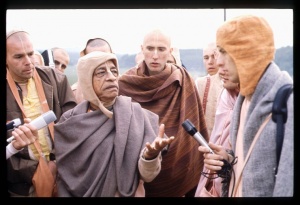CC Adi 5.39

A.C. Bhaktivedanta Swami Prabhupada
TEXT 39
siddha-lokas tu tamasaḥ
pāre yatra vasanti hi
siddhā brahma-sukhe magnā
daityāś ca hariṇā hatāḥ
SYNONYMS
siddha-lokaḥ—Siddhaloka, or impersonal Brahman; tu—but; tamasaḥ—of darkness; pāre—beyond the jurisdiction; yatra—where; vasanti—reside; hi—certainly; siddhāḥ—the spiritually perfect; brahma-sukhe—in the transcendental bliss of becoming one with the Supreme; magnāḥ—absorbed; daityāḥ ca—as well as the demons; hariṇā—by the Supreme Personality of Godhead; hatāḥ—killed.
TRANSLATION
“Beyond the region of ignorance [the material cosmic manifestation] lies the realm of Siddhaloka. The Siddhas reside there, absorbed in the bliss of Brahman. Demons killed by the Lord also attain that realm.”
PURPORT
Tamas means darkness. The material world is dark, and beyond the material world is light. In other words, after passing through the entire material atmosphere, one can come to the luminous spiritual sky, whose impersonal effulgence is known as Siddhaloka. Māyāvādī philosophers who aspire to merge with the body of the Supreme Personality of Godhead, as well as demoniac persons who are killed by Kṛṣṇa, such as Kaṁsa and Śiśupāla, enter that Brahman effulgence. Yogīs who attain oneness through meditation according to the Patañjali yoga system also reach Siddhaloka. This is a verse from the Brahmāṇḍa Purāṇa.